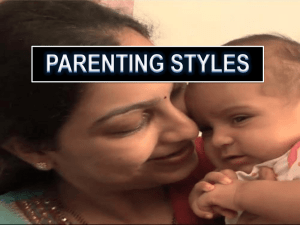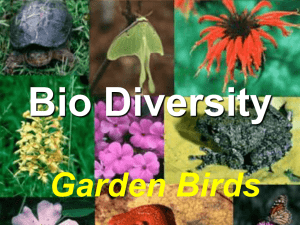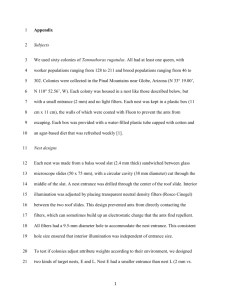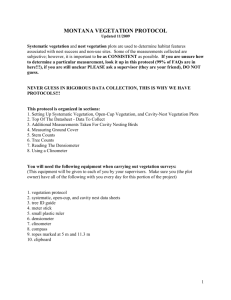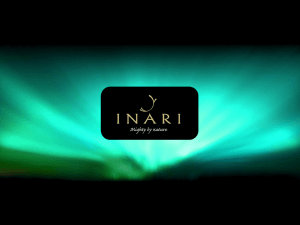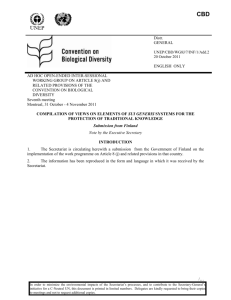Language nest in the context of inter
advertisement
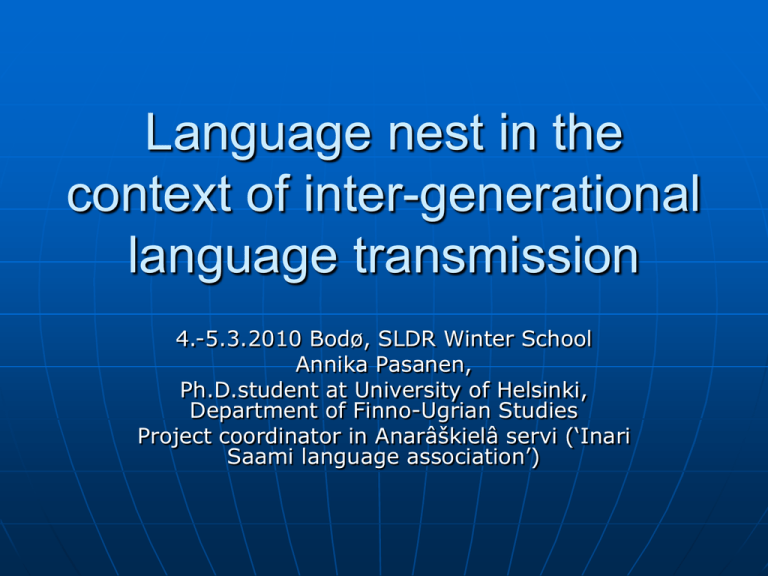
Language nest in the context of inter-generational language transmission 4.-5.3.2010 Bodø, SLDR Winter School Annika Pasanen, Ph.D.student at University of Helsinki, Department of Finno-Ugrian Studies Project coordinator in Anarâškielâ servi (‘Inari Saami language association’) Inter-generational language transmission The most important factor of vitality or endangerment of a language (e.g. UNESCO 2003) Most naturally happening at home between parents (or grandparents) and the children But what does it mean in practice? Roots of the language nest: Aotearoa First language nests in Aotearoa = New Zealand in 1982 By that time maori language seriously endangered, used only among elder maoris and in some spesific domains Rapid widening of the Kohanga reo –movement (for instance in 2004 545 nests with over 10 000 children) →Maori-medium schools and bilingual schools for Kohanga reo –children →Maori as a language of media and administration →Inter-generational language transmission at home??? Other languages having language nests Hawaiian 1984 → Skolt Saami in 1993 and 1997-2001 (Sevettijärvi) and 2008 → (Ivalo) Inari Saami 1997 → (Inari, 1997-2001 also in Ivalo) South Saami (Engerdalen) Lule Saami (Tysfjord and Jokkmokk) Karelian 2000-2006 (Uhtua) and 2009 → (Petrozavodsk and Nurmes) Finnish 2009 → (Petrozavodsk) Basic principles of language nest Only minority language is spoken by teachers since the first day Children are naturally allowed to speak in majority language; additive language learning vs. subtractive Focus on communication, not on teaching the language Language nest vs. language immersion Immersion in Canada: French for English-speaking children; in Finland: Swedish for Finnishspeaking children Basic methods used in activities are the same, but context and aim are different Language nest is a kind of early, total immersion in minority language Language immersion Usually for majority children Prestige of the target language; rational reasons to learn it Starting at the age of 4-5; successive bilingualism Role of the family: parents are not recommended to change the home language Continuing in school: immersion classes Language nest Usually for minority children Traditionally low prestige, but revitalization going on; mainly other than rational reasons Starting as early as possible; synchronic bilingualism Families encouraged toward RLS Not necessarily possibilities to continue in school Inari Saami language nest in Inari Founded in 1997 by Anarâškielâ servi In the beginning: 2 teachers; 8+2 children, 3-6 years old, all of them having Inari Saami roots; funded by Finnish Cultural Foundation Nowadays: 3 teachers; 10+2 children, 0-6 years old, part of them Finnish; funded mainly by Ministry of social affairs and health Karelian language nests in the Republic of Karelia, Uhtua (Kalevala) Founded in 2000 and 2002 as separate groups of two Russianspeaking kindergartens 12-14 children, 2 teachers + 1 nanny In 2006 two groups united as “Karelian-speaking kindergarten”, but at the same time principles of language nest abandoned Finno-Ugrian language nest project Started in 2008 Funded by Finnish Cultural Foundation Why? To promote language nest activities among Finno-Ugrian peoples especially in Russia How? Information concerning language nest, education of kindergarten teachers, methodological support, minor financial support for groups In Autumn 2009 partial language nest groups founded in the Republic of Karelia Language nest as a factor of intergenerational language transmission First aid on speech community’s way to RLS at home? Or constant necessarity and only way to inter-generational language transmission? Tendency of endangered speech communities to give responsibility to kindergartens and schools – how to strengthen parents’ role? ...crucial question: Will children, who have learnt minority language in the nest, transmit it to their own children? Promoting RLS at home Inari: language courses for parents and other adults; “Clinic of bi- and multilingualism” (being planned) Uhtua: “Tiijän mie i tietäy muamo” weekly evening courses for parents of the language nest Scotland: “Learning Gaelic before the child is born” –courses for young adults “Speak your mother tongue to your children” –information and raising awareness among young adults Holistic view in the revitalization Taking account of the whole entity of speech community and domains Chain of language maintenance / chain of factors maintaining the language (orig. kielensäilyttäjien ketju, Olthuis 2003): home – daycare – school – hobbies – friends – family – studies – work – social services – church Special attention on teenagers? Strengthening language use and linguistic identity among children and youngsters What do you suggest?




